1. Introduction
 Today we will be reviewing an external DVD Burner from LiteOn. The SLW 831SX is a slim external drive, mainly targeted at notebook users, who need to make backups or burn the occasional CD or DVD, and don't care about the low speeds that such a solution offers. The 831SX offers 8X for both DVD+R and DVD-R formats, while it also supports DL writing, even though this is done at the lowest available writing speed of 2.4X. RW formats are also supported at the 4X burning speed. As far as the CD media is concerned, the drive offers 24X burning speed for both CD-R and CD-RW media.
Today we will be reviewing an external DVD Burner from LiteOn. The SLW 831SX is a slim external drive, mainly targeted at notebook users, who need to make backups or burn the occasional CD or DVD, and don't care about the low speeds that such a solution offers. The 831SX offers 8X for both DVD+R and DVD-R formats, while it also supports DL writing, even though this is done at the lowest available writing speed of 2.4X. RW formats are also supported at the 4X burning speed. As far as the CD media is concerned, the drive offers 24X burning speed for both CD-R and CD-RW media.
Throughout these pages, we will see how the drive performed with a variety of media, in order to check the drive's Reading, Writing, Error Correction and Ripping capabilities.
- Features
- SMART-BURN avoiding Buffer UnderRun error, Automatically adjusting writing strategy & running OPC to provide the best burning quality.
- SMART-X function adjusts CD-DA / VCD / DVD data extraction to a fastest allowable speed according to both data request rate from host and disk quality.
- Specifications
| Model |
LiteOn SLW 831SX |
| DVD |
Write |
DVD+R 8X(10800KB/sec) maximum by Z-CLV |
| DVD-R 8X(10800KB/sec) maximum by Z-CLV |
| DVD+R DL 2.4X(3240KB/sec) maximum by CLV |
| ReWrite |
DVD+RW 4X(5400KB/sec) maximum by Z-CLV |
| DVD-RW 4X(5400KB/sec) maximum by ZCLV |
| Read |
8X(10800KB/sec) maximum by CAV |
| Access time |
130 ms |
| CD |
Write |
CD-R 24X(3600KB/sec) maximum by Z-CLV |
| ReWrite |
CD-RW 24X(3600KB/sec) maximum by Z-CLV in UltraSpeed disc |
| Read |
24X(3600KB/sec) maximum by CAV |
| Access time |
110 ms |
| Buffer Size |
2MB (Max) |
| Compatibility |
MS-Windows 98SE / ME / 2000 / XP |
| MTBF ( Life ) |
60,000 Hours |
| Environment |
5 to 35; Relative Humidity: 10% to 80% (non-condensing) |
| -40 to 65; Relative Humidity: 10% to 90% (non-condensing) |
| Dimension |
138.0 ( W ) x 24.37 ( H ) x 155.2 ( D ) mm |
| Weight |
362.8 g |

Below are the drive's main specs as given by NeroInfoTool and DVDInfoPro and VSO inspector:
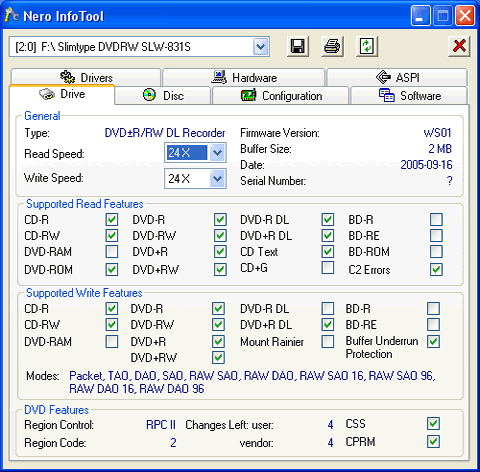


- Retail package

The retail version includes the LiteOn SLW-831SX, the power adapter, and along with these the package includes Nero 6, the well known CD-DVD burning software and the also famous PowerDVD 5 for your DVD playback needs.
-The Drive
The drive uses the Caddy (slot in) media feed, as seen in the below picture. The front panel hosts the DVD ROM and RW logos, as well as the activity LED and the eject button right of centre. There's no emergency eject hole.

On the unit's rear panel, there are the USB connection and power adapter input.

The drive's label, can be found on the back of the drive...

- Installation

The drive was installed under WindowsXP, and was
recognized as "Slimtype DVDRW SLW-831S". The drive came with the default firmware (WS01) . All reading and burning tests were made with this firmware installed as no later revision has been released.
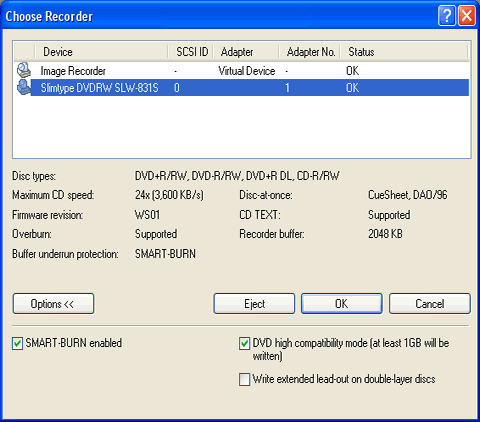
Due to the nature of the drive, we will not be comparing it with any other devices in this review and all tests posted will refer only to this drive.
2. Reading Tests
- CD Format
 The Slimtype supports 24X reading speed for CD media (pressed) and 24X for Re-Writable CD media. What follows is the average, start and end (max) reading speeds achieved for each media format.
The Slimtype supports 24X reading speed for CD media (pressed) and 24X for Re-Writable CD media. What follows is the average, start and end (max) reading speeds achieved for each media format.


The drive confirms the manufacturer's specifications. In both cases, the maximum supported speed of 24X was reached.
- AudioCD
For these tests, we used a pressed AudioCD and the Advanced DAE CDSpeed feature.


According to the CD-Speed Advanced DAE Quality test, the drive was awarded a quality score of 100 and an average DAE speed of 17.04X. It supports Leadin and Leadout, as well as CD Text and Subchannel Data. Note that for the On-the-fly copying test, the drive was rendered unable to perform the function at speeds higher than 10X.

- 90mins Audio disc

- 99mins Audio disc

Unfortunately, the drive cannot read either 90 or 99mins audio discs.
- DVD Format
 We repeated the reading tests, this time using a collection of pressed SL and DL DVD media to test the drive's reading capabilities with DVD media and posted the results in the graphs below.
We repeated the reading tests, this time using a collection of pressed SL and DL DVD media to test the drive's reading capabilities with DVD media and posted the results in the graphs below.

Once more, the test confirms the manufacturer's specifications.

The two layers of a PTP DVD-ROM disc are read sequentially with the drive starting reading from the inner part of the disc, which is the beginning of each layer, progressing towards the outer range, for each layer. Maximum supported speed for the reviewed drive is 8X in this case.

The graph shown above indicates the reading performance of the drive with OTP dual layer media. The first layer of an OTP dual layer DVD-ROM is read exactly the same way as the first layer of the PTP disc we tested previously. The difference here is the reading strategy of the second layer of the disc. The beginning of the second layer is located in the outer part of the disc, so the drive starts reading from the outer tracks towards the inner part of the disc. Same performance as the PTP disc, due to the 8X maximum reading speed with DL media.


With WriteOnce media, the drive reported same average speed of 6.36X for both +R and -R formats due to its cap at 8X reading speed, while with Re-Writable media, the drive again produced similar speeds for both formats achieving 6X maximum reading speed.

Slow ripping from the drive, with an average ripping speed of 4.4X.
From the above tests, we can conclude that the drive is slow. However, the specific drive is not intended to be a fast reader. It doesn't have to be since it's an external solution for notebooks.
- Appendix
Nero CD-DVD Speed Graphs
3. CD Error Correction
In the following tests, we check the drive's behavior when it comes to reading
scratched / defective discs. The test discs we use are the ABEX series
from ALMEDIO.
- ABEX TCD-721R


|
Errors total |
Num: 1080541 |
|
Errors (Loudness) dB(A) |
Num: 54080 |
Avg: -73.7 dB(A) |
Max: -23.1 dB(A) |
|
Error Muting Samples |
Num: 3438 |
Avg: 1.0 Samples |
Max: 8 Samples |
|
Skips Samples |
Num: 0 |
Avg: 0.0 Samples |
Max: 0 Samples |
| Total Test Result |
76.6 points (of 100.0 maximum) |
| C2 Accuracy |
99.7 % |
Good performance was reported while testing the drive with the 721 test media. The total error count is average while most importantly, no samples were skipped. Although the maximum error loudness is at -23.1 dB(A), if we take a look at the graph above, we will see that this was a single case while for the rest, the level remained below -36.0 dB(A).
- ABEX TCD-726


|
Errors total |
Num: 0 |
|
Errors (Loudness) dB(A) |
Num: 0 |
Avg: - dB(A) |
Max: - dB(A) |
|
Error Muting Samples |
Num: 0 |
Avg: 0 Samples |
Max: 0 Samples |
|
Skips Samples |
Num: 0 |
Avg: 0 Samples |
Max: 0 Samples |
|
Total Test Result |
100 points (of 100.0 maximum) |
| C2 Accuracy |
100 % |
Flawless reading with the 726 test media. 100 points in total test result and 100% C2 accuracy.
- CD-Check Audio Test Disc
 The CD-Check Test Disc is a very useful tool for evaluating the Sound Reproduction
/ Error correction capabilities of a CD player. The disc offers a signal combination
with disc error patterns to rate the drive's ability to read music and reproduce
it completely. Five tracks on the disc contain a sequence of progressively
difficult tests. These tracks are referred as Check Level -1 through Check
Level -5.
The CD-Check Test Disc is a very useful tool for evaluating the Sound Reproduction
/ Error correction capabilities of a CD player. The disc offers a signal combination
with disc error patterns to rate the drive's ability to read music and reproduce
it completely. Five tracks on the disc contain a sequence of progressively
difficult tests. These tracks are referred as Check Level -1 through Check
Level -5.
The
tracks are reproduced (played) through a software multimedia player
(i.e. Windows Media Player). Each level is considered as passed, if the tone
coming
out
from the speakers is smooth, continuous without interruptions, skipping or
looping. The higher the Check Level passed, the more reliable the sound reproduction
of the tested device.
|
Error Level |
1 |
2 |
3 |
4 |
5 |
|
LiteOn SLW 831SX |
5/5 |
5/5 |
5/5 |
0/5 |
0/5 |
Average performance in this case, with the CD-Check Audio Test Disc. The drive managed to read up to the 3rd error level. In the 4th level, audible clicks were present and the drive could not reproduce the track correctly.
Overall, good CD error correction capabilities.
4. DVD Error Correction
In the following tests, we examine the DVD reading capabilities of
the LiteOn SHM-165P6S drive with scratched / defective
DVD media.
For the tests we used CDVD Benchmark and Nero CDSpeed. The reference test
media
comes
from
ALMEDIO.
- Single Layer media
ABEX TDR-821
This is a single sided, single layer DVD-ROM with 4.7GB capacity, and its
surface has an artificial scratch of dimensions varying from 0.4 to 3.0 mm.
The following transfer rate picture comes from the CDVD Benchmark v1.21 transfer
rate test.


The maximum reading speed achieved was 8X with no drops in speed.
ABEX TDR-825
This is also a single sided, single layer DVD-ROM of 4.7GB capacity. The
data structure of the disc is exactly the same as that of the TDR-821, with
the difference that there are no scratches on it but instead, defective areas
of dimensions ranging from 0.5 to 1.1 mm. There are also fingerprints sized
between
65 and
75 micrometers.


Once more, maximum reading speed with this media was 8X, while we had smooth reading all the way to the end. The drive passed over both defective areas without producing any errors.
- Dual Layer media
ABEX TDR-841
This is an 8.5GB dual layer, single sided DVD-ROM disc with artificial scratches
of dimensions ranging from 0.4 to 3.0mm, on both layers.


With DL media, the maximum speed was 6X on both layers, while no errors were reported and the reading was completed successfully.
ABEX TDR-845
This test disc is a single sided, dual layer DVD-ROM disc with a capacity
of 8.5GB. The only difference between the TDR-845 and the TDR-841 discs is
that the first includes
defective areas and fingerprints. The dimensions of the defective areas ranges
from 0.5 to 1.1 mm and the fingerprints are sized from 65 to 75 micrometers.


Same performance as with the 841 DL media. The scattered yellow dots in the graph are instantaneous speed changes, which however, did not affect the reading of this test disc.
ABEX TDV-541
The TDV-541 is a single sided, dual layer DVD-VIDEO disc, with a capacity
of 8.5GB. The disc is based on the TDV-540 series which is designed for inspection
and adjustment of DVD-VIDEO players. The disc checks the layer switch operation
from layer 0 to layer 1 and also includes test pictures and test signals for
DVD sound files. The current TDV-541 also checks the error correcting
capabilities of the drive and includes scratches from 0.4 to 3.0 mm.

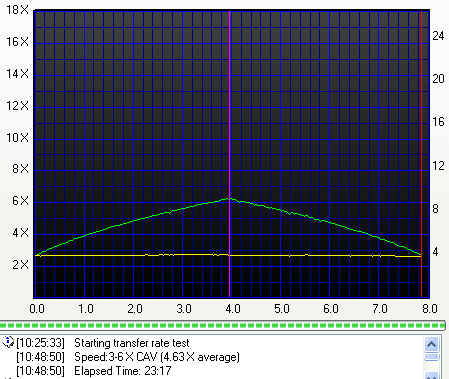
Excellent performance with the 541 media. Both layers were read flawlessly.
ABEX TDV-545
The
TDV-545 disc is based on the TDV-540 series. It is a single sided, dual layer
DVD-VIDEO disc with a capacity of 8.5GB. The TDV-545 includes artificial black
dots on the data surface, sized from 0.4 to 1.0 mm. It also has 65 - 75
micrometer fingerprints.

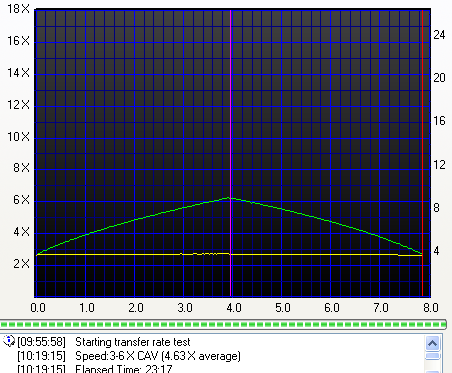
Same performance as with the 541 test media. Smooth reading all the way to the end.
- Conclusion
Overall, very good error correction capabilities from the Slimtype 831S drive. It read over all the defective areas, although at low speeds, and we can say that the drive is very good at handling most if not all, defective media that might crop up.
5. Protected Discs
We will now check the drive's ability to read and backup protected CDs.
- AudioCD protections
 For the test procedure we used three audio discs with different audio copy protections. The ripping process on all protected Audio discs was carried out with Exact Audio Copy v0.9 beta5.
For the test procedure we used three audio discs with different audio copy protections. The ripping process on all protected Audio discs was carried out with Exact Audio Copy v0.9 beta5.
The protected Audio discs tested, were:
| Audio Discs |
Protection |
| Celine Dion - New Day Has Come |
Sony's Key2Audio |
| Natalie Imbruglia - White Lilies Island |
Cactus Data Shield 200 |
| Aiko Katsukino - The Love Letter |
Cactus Data Shield 200.0.4 - 3.0 build 16a |
The Cactus Data Shield 200, contains artificial errors that are not easily bypassed by the reader, while the Key2Audio contains a second session causing problems to readers when trying to read the Table Of Contents (TOC).
The tested tasks are:
- Recognition of the inserted disc (Yes/No).
- Ripping all wav files(with EAC's Burst Mode) to the hard disk through copy&compare function.
- Listening to the produced wav files to detect any possible click/skips.
The drive recognized up to the 12th Audio track in the CDS200 disc,

and with the "Retrieve Native TOC" option removed, the drive recognized the 13th track.

The test results are shown in the following table:
|
Key2Audio |
CDS200 |
LiteOn SLW 831SX |
Ripping process completed, EAC reports no problems, Read&Test CRC comparison successful for all tracks. |
Ripping process completed, EAC reports no problems, Read&Test CRC comparison successful for all tracks |
Both protected Audio discs were ripped successfully and reproduced successfully.
- Cactus Data Shield 200.0.4 - 3.0 build 16a (Aiko Katsukino - The Love Letter)
This is a "special" CDS200 build, since it doesn't contain any artificial errors which create problems during the ripping process. Most problems occur when trying to write the ripped wav files, since the produced CD-R disc contains C2 and CU errors! This "problem" is rumored to be connected to specific chipset weaknesses.
|
CDS 200.0.4 - 3.0 build 16a |
LiteOn SLW 831SX |
Reading performed without any errors. |
- Games Protections
 To create the image of the various protected titles in the hard disk, we used Alcohol 120% software and the appropriate settings, in accorda
nce with the protection type of the inserted discs. Below you can see the duration of each process as well as the transfer rate in each case.
To create the image of the various protected titles in the hard disk, we used Alcohol 120% software and the appropriate settings, in accorda
nce with the protection type of the inserted discs. Below you can see the duration of each process as well as the transfer rate in each case.




Satisfactory times for all three discs, with safedisc requiring just under 20mins, which is traditionally the hardest disc to rip for most devices.
- Writing Tests
The LiteOn SLW 831SX supports the DAO-RAW writing mode. To check the drive's
EFM correction status, we used 5 different game titles with different SafeDisc
2 versions, having the latest software patches installed. After making the images
of the various titles onto the hard disk, we burned them (at maximum speed) with
Alcohol 120% v1.9.2.3105. Two different discs were recorded for each title;
one with the "Rectify Sub-Channel Data" enabled and one with the function
disabled.
- Quake 4 SafeDisc v4.6
- Fifa 2004 - SafeDisc v3.1x
The drive failed to create working backups of the above protected games.
6. CD Recording Tests
According to the manufacturer's specifications, the drive supports 24X writing speed for both CD-R and CD-RW media.
According to Nero CDSpeed, the drive confirmed the maximum 24X speed. The
test started at 10.01X and finished at 24.05X, having an average speed of 17.07X.
Click on the image below for a larger view.
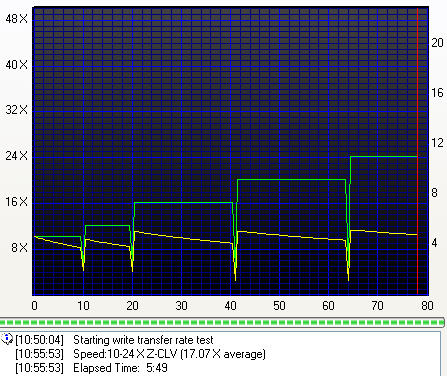
For the burning tests, we created an 80min data compilation with Nero
Burning Rom, recording the data on a few 700MB discs. The drive
needed 5:49 minutes to complete this task at the
maximum 24X writing speed.
In the following graph we can see the recording times the LiteOn SLW 831SX reported with various CD-R media inserted.

The LiteOn SLW 831SX supports 24X Z-CLV rewriting speed with Ultra Speed Re-Writable Media
(US-RW).
Below you can see the Nero CD-DVD Speed writing simulation test with blank
24X US-RW media from Mitsubishi Chemicals.

The drive reached a maximum writing speed of 23.97X having an average speed of 22.46X. The test ended after 5:43mins.
- Overburning Test

According to Nero CD-DVD Speed, the drive supports overburning.
7. CD Writing Quality - Plextools
 We measured the C1 / C2 error rate on the recorded discs we burned at the
maximum supported writing speed of 48X. The software we used is PleXTools Professional
v2.28, and more specifically the built-in Q-Check utility. The
reader was the Plextor PX-716A (firmware v1.09).
We measured the C1 / C2 error rate on the recorded discs we burned at the
maximum supported writing speed of 48X. The software we used is PleXTools Professional
v2.28, and more specifically the built-in Q-Check utility. The
reader was the Plextor PX-716A (firmware v1.09).



- Summary
From the above scans, we can clearly see that the drive lacks in CD recording quality, as two out of three media burned were found to be of poor quality, according to the Plextools Pro q-check utility. Only with Philips media could the drive produce acceptable results. Let's see what the Clover Systems CDX Q-check utility reports.
8. CD Writing Quality - Clover System
Untitled Document
The Clover Systems CDX Compact Disc Analyzer is a high-speed tool to quantitatively measure the quality of a CD. It will analyze CD-DA, CD-ROM, CD-ROM XA, CD-I, CD-R, Photo-CD, Enhanced CD and CD-RW discs at 4X, 8X, 24X, 32X or 40X speed. It effectively measures disc quality by examining the quantity and severity of CIRC errors generated during playback. It also provides the capability to measure signal parameters related to pit geometry, such as asymmetry and reflectivity. Together, all these bits of information provide a thorough analysis of disc quality. The Clover Systems Analyzers can also perform various format-checking tests on data discs, and do bit-for-bit data comparison on all types of CDs. All tests are carried out at the maximum speed of 40X.
CIRC error correction uses two principles to detect and correct errors. The first is redundancy (extra information is added, which gives an extra chance to read the disc), and the second is interleaving (data is distributed over a relatively large physical area). The CIRC error correction used in CD players uses two stages of error correction, the well known C1 and C2, with de-interleaving of the data between the stages.
The error type E11 means one bad symbol was corrected in the C1 stage. E21means two bad symbols were corrected in the C1 stage. E31 means that there were three or more bad symbols at the C1 stage. This block is uncorrectable at the C1 stage, and is passed to the C2 stage. Respectively, E12 means one bad symbol was corrected in the C2 stage and E22 means two bad symbols were corrected in the C2 stage. E32 means that there were three or more bad symbols in one block at the C2 stage, and therefore this error is not correctable.
BLER (Block Error Rate) is defined as the number of data blocks per second that contain detectable errors, at the input of the C1 decoder. Since this is the most general measurement of the quality of a disc, you will find BLER graphs for all media tested below. If you click on the images you can see a more detailed table, indicating error levels. The Red Book specification (IEC 908) calls for a maximum BLER of 220 per second averaged over ten seconds. Discs with higher BLER are likely to produce uncorrectable errors. Al low BLER shows that the system as a whole is performing well, and the pit geometry is good. However, BLER only tells us how many errors were generated per second, and it does not tell us anything about the severity of those errors.

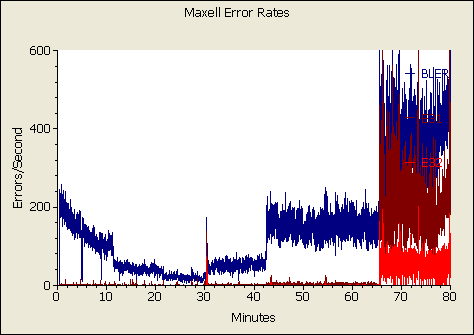

- Summary

More strict than Plextools Pro, the Clover CDX system did not award a pass grade to any of the three media tested, not even Philips which, in the previous page, was rated as good. Certainly the Philips media produced a better burn than the other. Overall though, poor CD burning.
9. DVD Writing Tests
- Writing Performance
The maximum supported speed is 8X Z-CLV for both the DVD+R and DVD-R formats. For DVD+RW and the DVD-RW media, max speed is 4X CLV.
By using Nero CD-DVD Speed with DVD-R and DVD+R media, we are able to see the writing strategy of the drive for both formats at 6X burning speed.
- 8X DVD+R Single Layer writing

The drive completed successful DVD+R writing at 6X in 13:06mins.
The test started at 2.45X, reached a maximum writing speed of 6.13X and
reported an average speed of 5.28X.
- 8X DVD-R Single Layer writing

The drive completed successful DVD-R writing at 6X in 13:05mins. The test started at 2.03X, reached a maximum writing speed of 6.06X and reported an average speed of 5.31X.
- Burning Tests

We burned a variety of 8X enabled DVD-R media. Even though some media were burned at their certified speeds, the burn times resembled more of a 4X burn than 8X. While most of the times are slow, Datawrite Titanium media reported a "record" time of 42:10! Totally unacceptable, which, as we will see later on, also resulted in a bad burn.


Different format, same scenario. All writing times resemble 4X burning speed and as we will see later on with this media as well, even at this low speed, the drive could not produce good quality.

- DVD Overburning Test

The drive does not support DVD overburning for both the -R and +R media formats, giving the above error messages.
10. DVD Writing Quality - Page 1
In order to test the writing quality and readability of the burned media we
used two readers with two software applications:
- The LiteON SOHD-167T with patched firmware being able to read DVD5 up to 16X CAV and DVD9 up to 10X CAV. For the transfer rate tests we used the latest Nero CDSpeed version.
- The Plextor PX-716A with the latest available firmware. For scanning the disc, we used the latest PlexTools version at 2X CLV reading speed, BURST mode, with middle accuracy.
In general, a "perfect" disc should have a smooth reading curve,
very low PIE/POE and zero (0) POF error rates. Most times however, even though
a disc has very low PIE/POE error rates, the reading curve may not be smooth
containing speed drops. Due to the fact that we oversped the reading capabilities
of the LiteON SOHD-167T, such drops are expected, especially near the outer
area of the disc.
The measurements below should be taken not as the absolute criteria of the burning quality, but as an indication level.
8X DVD+R Writing Speed
- BenQ 8X DVD+R @ 4X


- Bulkpaq 8X DVD+R @ 8X


- Datawrite Titanium 8X DVD+R @ 6X


- Maxell 8X DVD+R @ 4X


-Optodisc 8X DVD+R @ 8X


- Ricoh 8X DVD+R @ 8X


- TY 8X DVD+R @ 8X


- Summary
As we can see from the above scans, we have poor writing quality with almost all burned media according to both Plextools and CDSpeed. Most of the media did not manage to complete the scans, due to very bad condition of the disc(errors), while those that were read reported very bad results with woeful CDSpeed graphs and high error counts and values.
11. DVD Writing Quality - Page 2
In order to test the writing quality and readability of the burned media we
used two readers with two software applications:
- The LiteON SOHD-167T with patched firmware being able to read DVD5 up to 16X CAV and DVD9 up to 10X CAV. For the transfer rate tests we used the latest Nero CDSpeed version.
- The Plextor PX-716A with the latest available firmware. For scanning the disc, we used the latest PlexTools version at 2X CLV reading speed, BURST mode, with middle accuracy.
In general, a "perfect" disc should have a smooth reading curve,
very low PIE/POE and zero (0) POF error rates. Most times however, even though
a disc has very low PIE/POE error rates, the reading curve may not be smooth
containing speed drops. Due to the fact that we oversped the reading capabilities
of the LiteON SOHD-167T, such drops are expected, especially near the outer
area of the disc.
The measurements below should be taken not as the absolute criteria of the burning quality, but as an indication level.
8X DVD-R Writing Speed
- Datawrite Yellow 8X DVD-R @ 4X


- Optodisc 8X DVD-R @ 4X


- Prodisc(F01) 8X DVD-R @ 8X


- Ridisc 8X DVD-R @ 8X


- Traxdata 8X DVD-R @ 8X


- TY 8X DVD-R @ 6X


- Summary
Again, terrible quality. All media could either not be read or had bad speed graphs and/or Plextools scans.
12. DVD Writing Quality - Page 3
In order to test the writing quality and readability of the
burned media we are used two readers with two software applications:
- The LiteON SOHD-167T with patched firmware being able to read DVD5 up to 16X CAV and DVD9 up to 10X CAV. For the transfer rate tests we used the latest Nero CDSpeed version.
- The Plextor PX-716A with the latest available firmware. For scanning the disc, we used the latest PlexTools version at 2X CLV reading speed, BURST mode, with middle accuracy.
In general, a "perfect" disc should have a smooth reading curve,
very low PIE/POE and zero (0) POF error rates. Most times however, even though
a disc has very low PIE/POE error rates, the reading curve may not be smooth
containing speed drops. Due to the fact that we oversped the reading capabilities
of the LiteON SOHD-167T, such drops are expected, especially near the outer
area of the disc.
The measurements below should be taken not as the absolute criteria of the burning quality, but as an indication level.
4X ±RW Writing Speed







- Summary
According to both Plextools and CDSpeed, only -RW media managed to report barely acceptable results. According to CDspeed Q-Check, the transfer rate graphs are shaky and the Plextools scans have among other things, high POE values. Overall, to poor writing quality.
13. DVD Writing Quality - Almedio
The AEC-1000 consists of a DVD Drive and the "ALChecker" error measurement application which can check the written data quality. The application is capable of 1X CLV measurement as well as 4X CLV on DVD-Video/ROM and finalized DVD+R/-R media.
There are three measurement modes:
- Fine Mode: checks a series of eight consecutive ECC blocks,
- Rough Mode: checks eight consecutive ECC blocks every 100h ECC blocks
- Quick Mode: checks three specified areas
The checking status is shown graphically in real time while you can save the error graph at the end of the test. The reported errors are the PI and the UncPO. In the case of PI, it counts the number of rows corrected by the PI error correction in each group of eight consecutive ECC blocks. In the case of UncPO, it counts the number of ECC blocks in which more than one byte is uncorrectable in eight consecutive ECC blocks. For our quality scans, we set for 1X CLV and Fine Mode which is the slowest and with the safest results.
- Datawrite
Yellow 8X DVD-R @ 4X

- Ricoh 8X DVD+R @ 8X


- Datawrite Titanium 8X DVD+R @ 6X

- Optodisc 8X DVD-R @ 4X


Two out of four media tested were found to be of good condition. The Datawrite -R burned at 4X and Ricoh +R 8X certified but burned at 4X speed managed to pass this test, while the other two tested media reported high PI and PO values and thus failing the Q-Check test.
14. DVDR DL - Page 1
 We burned some DVD+R DL discs with data content. For this task we used "Create Data Disc" from Nero CDSpeed in order to fully burn the discs.
We burned some DVD+R DL discs with data content. For this task we used "Create Data Disc" from Nero CDSpeed in order to fully burn the discs.
Traxdata DVD+R DL 2.4X @ 2.4X

The drive started burning the media at 2.43X and maxed out at 2.52X with and average of 2.50X using CLV writing strategy. The burn ended at 43:20mins.
Philips DVD+R DL 2.4X @ 2.4X

Using Z-CLV writing strategy, the burn started at 2.43X reaching a max speed of 2.52X, reporting an average speed of 2.49X. The writing ended at 43:53mins.
15. DVDR DL - Page 2
In order to test the 831SX's DL writing quality, we used the LiteOn SOHD-167T and the Plextor PX-716A drives, to scan the burned media.
Traxdata DVD+R DL 2.4X @ 2.4X


Even though the CDSpeed utility reported a good burn with Traxdata DL media, the Plextools quality check utility reported bad quality media, and we can see the PI values exceeding the acceptable limits by far, with the media failing near the end of the scan.
Philips DVD+R DL 2.4X @ 2.4X


In the case of Philips media, things are even worse. Both Quality Check utilities reported bad results for the media. Poor quality once more.
- Summary
Obviously, the 831S is not the ideal burner to cover your DL burning needs. Even though this drive is meant as a quick backup solution and not as a primary backup device, we would like to see better burning quality for DL media.
16. 831SX vs SA300 - Page 1
For checking exactly what
the LiteOn SLW 831SX reports, we used different media, burned with other
recorders. The media have been measured with the well known AudioDev
SA300 DVD
CATS system at 1X.
The drive is capable of reporting PI/PIF errors, so we will compare those
measurements at 8X reading speed.
Please note that the posted results are only valid for the specific tested LiteOn SLW 831SX drive. Using other drives, even another SLW 831SX, can produce totally different
results.
#1st Test Disc - PISum8/PIF Comparison - 8X Reading speed



From the above graphs, we can see that for the PI Sum 8 Average, the trend is similar but the values are very different. With the PIF average, the LiteOn drive is very close to the CATS scans.
17. 831SX vs SA300 - Page 2
For checking exactly what the LiteOn SLW 831SX reports, we used three different media, burned with other recorders. The three media have been measured with the well known AudioDev SA300 DVD CATS system at 1X.
The drive is capable of reporting PI/PIF errors, so we will compare those measurements at 8X reading speed.
Please note that the posted results are only valid for the specific tested LiteOn SLW 831SX drive. Using other drives, even another SLW 831SX, can produce totally different results.
#2nd Test Disc - PISum8/PIF Comparison - 4X Reading speed



Here again, in the case of the PI Sum 8 average, the trend is similar but the values are very different whereas with PIF average, the LiteOn drive's graph resembles the CATS scan.
18. 831SX vs SA300 - Page 3
For checking exactly what the SLW 831SX reports, we used three different media, burned with other recorders. The three media have been measured with the well known AudioDev SA300 DVD CATS system at 1X.
The drive is capable of reporting PI/PIF errors, so we will compare those measurements at 8X reading speed.
Please note that the posted results are only valid for the specific tested LiteOn SLW 831SX drive. Using other drives, even another SLW 831SX, can produce totally different results.
#3rd Test Disc - PISum8/PIF Comparison - 4X Reading speed



The trend line is different from the Original CATS for the PI SUM8 average, but for PIF average, it is very similar.
19. 831SX vs SA300 - Page 4
For checking exactly what the LiteOn SLW 831SX reports, we used three different
media, burned with other recorders. The three media have been measured
using the well known AudioDev SA300 DVD CATS system at 1X.
The drive is capable of reporting PI/PIF errors, so we will compare those measurements at 8X reading speed.
Please note that the posted results are only valid for the specific tested LiteOn SLW 831SX drive. Using other drives, even another SLW 831SX, can produce totally different
results.
#4th Test Disc - PISum8/PIF Comparison - 4X Reading speed



With DL media, the graph is totally different from the original CATS scan.
20. Advanced Features
.gif) All LiteOn based drives support the Booktype setting, allowing the user to maximize compatibility. Users should
change to
the preferred booktype setting prior to burning +R, +RW or +R9 media.
All LiteOn based drives support the Booktype setting, allowing the user to maximize compatibility. Users should
change to
the preferred booktype setting prior to burning +R, +RW or +R9 media.
In order to achieve a booktype setting change, we used the well known booktype utility, BookType (version 1.3.5). We used blank DVD+R media, and tried to change its booktype to DVD-ROM, as seen in the following screen shots.
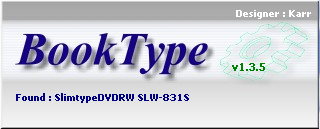
Selecting the desired Booktype for the inserted +R media...

Even though we get the message that the Booktype has been successfully changed, the "Current Disc Booktype" remains the same...

Unfortunately, the booktype of the +R inserted media, could not be changed. We checked with our +R test media burned with Nero Burning Rom, and all reported a +R booktype. In the case of the 831S, booktype setting change is not an option.
Since the drive is a LiteOn, the RPC region control can be easily disabled and the drive made region free.
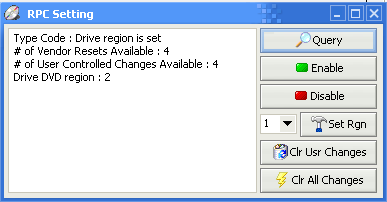

21. Conclusion
 As we stated at the beginning of this review, the LiteOn SLW 831S is not a drive one would use as a primary device. The 831S is targeted mainly at notebook users, who require a slim and compact unit, easy to carry around and one that covers basic needs such as backups. Hence, this drive offers low reading and writing speeds for both CD and DVD formats. Unfortunately, the drive is not only slow,.it's lacking a lot more than that.
As we stated at the beginning of this review, the LiteOn SLW 831S is not a drive one would use as a primary device. The 831S is targeted mainly at notebook users, who require a slim and compact unit, easy to carry around and one that covers basic needs such as backups. Hence, this drive offers low reading and writing speeds for both CD and DVD formats. Unfortunately, the drive is not only slow,.it's lacking a lot more than that.
As we saw in the foregoing pages of this review, the reading speed for both CD and DVD media is slow, especially in comparison to other external solutions, like the recently reviewed LG drive or even worse, internal drives. Its reading speed for CD media can reach as high as 24X for both CD Pressed and CD-RW media, while with DVD media, the max supported reading speed is 8X (DVD Pressed and DL). Unfortunately, the drive cannot read 90/99min audio discs, and its DVD ripping speed is not enough to render it a good ripping device (4X).
On the other hand, the error correction mechanism, is quite effective, and the drive reported some good results in our both CD and DVD error correction tests. With protected media, its performance was good, producing no errors when ripping protected audio discs.

When it comes to burning quality however, the drive has a lot of shortcomings. Unfortunately, the drive (even though the specifications mention 8X writing speed for both +R and -R media), did not managed to burn a single disc at that speed. Nero reported 8X available speed for some of the inserted media, but the time it took to burn the disc was more of a 4X. Times were typically around 14 minutes rather than the usual 8:00mins which is the average burn time for 8X media. One would then expect good writing quality at such low speeds. Alas, this is not the case, where 2 out of 3 inserted media either reported bad quality or did not make it through to the end of the quality tests, crashing out during the reading process. This goes for +R, -R, +RW, -RW and +DL media. CD burning quality was also affected by the drive's bad writing mechanism.
As far as features are concerned, LiteOn drive did not provide this drive with the full range of its well known and useful features. The drive could possibly be used as a quality checker (then again, how many end users really need that function), but it does not support the bitsetting function. It supports region free setting, but not overburning, for both CD and DVD media.
All in all, the drive is probably a very respectable reader, but not such a capable burner. We hope that LiteOn will look into and provide some solutions for a number of issues that cropped up during our testing procedures, especially with regards to burning quality. The drive can be found on the market at a price close to $126 including VAT.
- The Good
- Good CD - DVD error correction
- Supports protected Audio discs
-
Can be set to Region Free
- Can be used for DVD media error measurements
- The Bad
- Doesn't accurately backup SafeDisc2 v2.9x+ protected discs
- Cannot read 90/99min audio discs
- Poor CD- DVD writing quality
- Doesn't support Bitsetting
- Like to be fixed
- Improved DL, DVD-RW writing quality with more media
- Improved CD writing quality
| Retail Package |
 |
| Reading |
 |
| Error Correction |
 |
| Protected Discs |
 |
| Writing |
 |
| Features |
 |